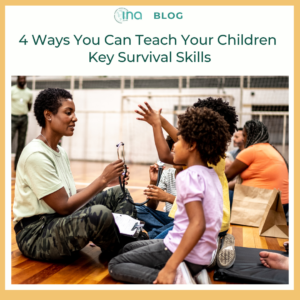
By Stephanie Long
In our modern age of technology, the amount of time children spend outside is gradually decreasing. Playing outdoors is often replaced by video games or watching TV, leading to children missing out on its many benefits. Spending time outdoors has been shown to have a positive impact on children’s development, boosting creativity, confidence and social skills.
What’s more, they often miss out on valuable learning experiences. Without exposure to wildlife and nature, they could lack the skills and knowledge to protect themselves. Not only is this helpful whenever they spend time outside, but these basic skills are vital should your child ever have to fend for themselves. In this guide, we cover four basic skills that any parent should teach their children.
Finding water nearby
Searching for nearby streams and waterfalls provides a sense of purpose and can make walks more engaging for children, helping them to get exercise without realising it. Looking out for something means they’re less likely to focus on walking and feel bored, instead encouraging them to continue their hunt.
A great way to find nearby water is to look out for hills as water will naturally flow downwards, creating streams or waterfalls. If that fails, look out for animal tracks as they’ll be frequent visitors of water sources.
Practicing this ritual regularly means children are likely to remember how to find safe drinking water – a skill that is invaluable should they find themselves on their own in the wilderness.
Building a campfire
Building a campfire can be crucial for someone who’s stranded. A fire provides a source of heat, light and a way to cook food. If your child is old enough that you think they’d be able to light a fire safely, teaching them how to collect the right materials can make a big difference.
Before thinking about lighting a fire, it’s important that children know how to create the base. They will need to be able to identify dry wood and know where to find it, so it’s a good idea to practice picking out the right logs. Similarly, children will need to collect tinder which commonly consists of dead, dry leaves, and thin twigs for kindling. Remember to keep safety as your top priority when near a fire with children. Be sure to always take the lead, set boundaries, and have the means to extinguish the fire if necessary.
Constructing a fort
Staying warm and dry is essential in the wild, and building a shelter is an easy way to achieve this. Building their shelter is probably the most fun survival skill for children to learn, but it’s important that they know which materials to use and how to properly secure it.
Just piling some branches and leaves together won’t hold up for long, and it often isn’t very insulating. Instead, find some sturdy logs and show your kids how to position them, then send them off to collect dead leaves and debris to fill the frame. This will provide insulation should they ever need to build a shelter on their own.
First aid basics
When children don’t have access to supplies that they’re familiar with, a minor injury can quickly become serious. For this reason, it’s a good idea to pack some mini first aid kits for your children to carry with them during any trips into the wilderness. Essential items include bandages, plasters, antiseptic wipes and some tape, but feel free to include anything you think may be helpful.
If you think your kids realistically wouldn’t carry around first aid kits, then it’s important to educate them on safe ways to treat injuries with items they can find in the wild. This could include how to remove insect stingers and splinters, creating a makeshift splint or finding natural antibacterial solutions.
Teaching your kids even the most basic survival skills is always worth the time. Every parent hopes their child would never find themselves in a situation where they’d need to use the skills, but it can be reassuring to know they’d be well-equipped in case of emergency. Not only that, but teaching your children these skills can be a valuable bonding experience, creating memories to last a lifetime.
Stephanie Long is a wilderness expert, running wild camping expeditions for children where they can learn new skills in fun ways. She also enjoys writing about her best tips and tricks, and is currently working on her first novel.
